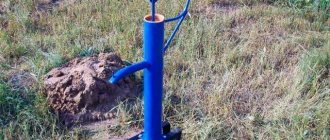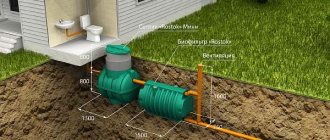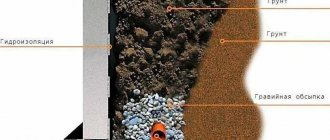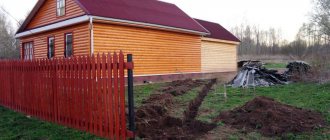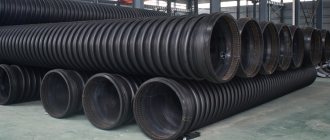Having purchased a country plot, the owners are faced with the need to equip a well. In order for this facility to comply with sanitary and hygienic standards and be safe during operation, it is important to choose the right location for the construction of the mine.
A reader contacted our editorial office who was faced with a similar problem: “I bought an inexpensive plot of land that did not have a centralized water supply. To provide the country house with water, I thought about building a well. I read on the Internet that you need to choose the right place to drill a well. I have a plot of rather modest size, on which a small house is built, and there are outbuildings. How to determine the optimal location for building a well?
We often receive similar questions. We have studied the topic and will provide comprehensive answers to readers’ questions. Next, we will consider the basic legal requirements, building codes and rules regulating this process.
It is advisable to plan the construction of a well before the construction of any objects on the site begins. However, more often it turns out, as in the case of our reader, that the house has already been built and the plot has outbuildings. What to do in this case? You need to carefully consider the site plan. When choosing a location to create a well, the ease of use of the facility is taken into account. It is important that the water intake point is located at an appropriate distance from sources of pollution, as well as other objects.
The well should not interfere with travel or cause damage to nearby objects, including other wells and neighbors’ buildings.
Legal norms
When building a well on a private plot, the requirements of the following legislative acts are taken into account:
- SNiP 30-02-97. This document has been updated in 2021. Now, when constructing wells with water consumption of more than 100 cubic meters per day, it is necessary to register the facility, obtain a license and pay taxes. SNiP specifies recommendations for the construction of facilities on the site. The local administration of SNT or another type of partnership specifies in the regulations the relevant requirements for the location of facilities. When drawing up the charter, the recommendations of SNiP are taken into account.
- SP 53.13330.2011. This guide allows you to determine the correct location for the well on the site diagram. It is used during the development of an allotment plan before the construction of residential and commercial facilities begins.
- SP 31.13330.2012. These rules regulate the construction of sanitary facilities on your own site.
Most often, shaft wells are created in suburban areas. They are built taking into account the water source on the neighboring site. The work of choosing a place to build a well should be entrusted to a specialist . If you do not take into account the depth and volume of the neighbors' water intake point, after construction the water may go into a new well. This will lead to disputes with neighbors. They will win the case in court, and your well will be closed at your expense. Therefore, it is worth carefully approaching the process of choosing a water intake point.
Observation when searching
When is the best time to dig a well in the Moscow region?
The ability to take note of everything and analyze the information collected has never been superfluous. It was in this way that our ancestors, who were not yet armed with the achievements of science and technology, found water. What facts and natural phenomena will help us in our search for water?
Observation #1 - summer fogs
Fogs may appear in the area during the warm season. This natural phenomenon happens either in the early morning or late in the evening.
If you observe fog in your area, pay attention to its density: it will be highest in the place where the water is closest to the soil surface.
If early in the morning you see fog in your garden, swirling or concentrated in one of its corners, then you can say with confidence that there is water in your area
The cause of such fog is the evaporation of water that is located underground. It will not stay in one place like ordinary fog. Moisture vapor may swirl or travel very low to the ground.
Observation #2 - animal behavior
Unlike people, animals know exactly where underground water is. It's a shame they can't tell us about it. Yes, they won’t be able to tell you, but please share your knowledge.
By observing the behavior of domestic and wild animals and birds, we can obtain all the necessary information:
- Dog. A dog is a man’s friend and will definitely help him in finding water for a well. In the heat, dogs are always looking for an opportunity to cool their body, so they dig holes where it is cooler. These are exactly the places we are looking for.
- Horse. When thirsty, a horse hits its hoof in a place where there is water underground.
- Harvest mouse. But mice love where it is dry. They will never make their nests near places of high humidity. It’s better to climb a tree or some building that rises above the ground level.
- Domestic bird. Chickens do not lay eggs where it is wet, but geese, on the contrary, choose places where underground aquifers intersect for their nests.
Even midges feel the proximity of water. If we look at its behavior at dusk, when the summer heat has already subsided, we will see columns of insects circling in the air precisely over those places where it is coolest - where there is what we need underground.
Dogs, like people, have difficulty withstanding heat and drought. They try to get to the coolest layers of soil, which are located just above the aquifer.
In a place unwittingly indicated to us by representatives of the animal world, we can safely dig an Abyssinian well to obtain water for watering the garden and for maintaining the territory.
Observation #3 - types of growing plants
Who would know about the presence or absence of water on the site, if not the plants? It is not surprising that they are used as indicators. If blackberries, buckthorn, lingonberries, bearberry, bird cherry, wood lice and wild rosemary are doing well on your site, then it makes sense to look for an aquifer - it is definitely present.
Plants do not always like excess water. If there is too much of it, they may even get sick and stop bearing fruit.
Take a closer look at the birch: its modest growth and gnarled trunk with curvatures indicate the presence of a nearby watercourse. Coniferous trees also prefer to grow where it is dry.
By the way, the presence of nearby groundwater is not always a benefit for gardeners. After all, cherries and apples prefer moderate humidity: their waterlogging can provoke tree diseases and fruit rotting.
Observation #4 - help from friends and neighbors
If your property is part of a gardening society or you have neighbors nearby, be sure to talk to them. As a rule, they have already solved the problems that you are struggling with today. If there is an operating well or well on their site, then you will have water too.
It is worth asking your neighbors at what depth the water is in their source and whether the level is stable. In this way, it is easiest and easiest to collect information and plan work on. For private owners, surveying the owners of adjacent plots is the only expedient way to obtain hydrogeological data.
You should always maintain friendly relations with your neighbors: they will be the first to come to your aid, and if something happens, they will protect your property from thieves
Try to find out not only the current state of the local water intake, but also fluctuations in water levels throughout the year, as well as the composition of the water. Agree that it is not very pleasant to find your site flooded with flood waters in the spring. Receive vital information in a timely manner.
Ideal location
Owners of suburban areas have to follow a whole set of rules when placing allotment objects. It is especially difficult for owners of narrow and small areas to choose the optimal location for drilling a well. An ideally located well should:
- Be located at a sufficient distance from the foundation so as not to cause the destruction of the house due to erosion of the foundation.
- Don't disturb your neighbors.
- Don't be too far from home. Otherwise, a complex communications system will be required, which will be expensive and will become clogged.
- Keep at a sufficient distance from sources of pollution.
- Do not interfere with travel, passages, trees, or garden crops.
- Stay away from the road.
- Be higher than the level of the septic tank (cesspool) on your own and neighboring plots.
- Keep away from objects on the site at the distance established by SNiP.
It is sometimes very difficult to comply with all the requirements. If you can find a suitable place to drill, there is not always water there. This makes finding a suitable location a difficult process.
Concrete structures
A reliable, strong and durable building material for the manufacture of wells is reinforced concrete. For 6-meter structures, 60-70 cm reinforced concrete pipes are used.
To eliminate the possibility of them falling into the ground, when lowering the concrete rings, you must act as carefully as possible. At the same time, professionals dig up the soil, starting from the diameter of each ring. Each of the rings is lowered under the influence of their weight.
It is necessary to take into account the nuances:
- Support the rings with wooden logs (deep holes are dug for them, and after digging up the soil they are gradually removed);
- Rings with a diameter of 1 meter or more are lowered using a construction winch mounted on a tripod;
- After the required depth has been dug, gravel is poured into the bottom of the well in large quantities so that the incoming water is clean.
Neglecting the last rule and saving on gravel increases the risk of silt getting into the water, due to which it will lose its natural taste and become cloudy.
Distance from foundation
It is easier to choose the optimal location for building a well shaft when the house has not yet been built. If the building already exists, it is worth considering the type of foundation. Shallow foundations of houses are especially affected by the proximity of a well shaft. If the building is built on a strip foundation on clay, the well is made as far as possible.
In accordance with SNiP 30-02-97, the minimum distance from the well to the base of the house is 3 m. But it is better to build a well at a distance of up to 5 m.
This safety measure is necessary, since after digging a mine, the water rises 1.5-2 m relative to the aquifer. Therefore, wells of shallow depth will be the most problematic during operation. Such mines are located in areas where groundwater comes close to the surface. After constructing a well shaft, flooding may occur. The water level will rise and will seep through the walls of the mine.
This leads to erosion of the foundation. Over time, it will collapse, which entails the most undesirable consequences for the building. It is not safe to live in such a house. The well shaft must be properly sealed. It is best to use reinforced concrete rings in this case. When using stone, brick or wood to build a mine, you need to choose high-quality materials for sealing.
Determining a place for a well
In addition to the presence of an aquifer, to determine the optimal location, you need to decide whether to choose a well or a well. It is also very important to take into account sanitary rules.
In order to prevent runoff and pollution from getting into the well water, it must be located no closer than 25 meters from potential sources of pollutants. Such unfavorable environmental sites include toilets, garbage pits, stockyards, sewer networks, old wells with suspected contamination, cemeteries and cattle burial grounds, warehouses with the potential danger of leakage of toxic substances, fields treated with pesticides. Many toxic substances enter groundwater and then into wells and adversely affect human health, without changing the taste of the water.
Please note that many agricultural fertilizers are potential sources of disease. Thus, the well-known salts of nitric acid or nitrates are widely used in agronomy, but in no case should they enter the human body.
In addition, when choosing a place to build a well, pay attention to the waterproofness of the top layer of soil adjacent to the building. It is also not recommended to dig wells in places that can be flooded by flood or melt water, as they carry a huge amount of dirt.
Types of well structures
The best time to dig a well is in the fall. During this season, groundwater goes deeper and you will avoid the danger of premature flooding. Before digging a well, decide on its type. It can be formed in the form of a full-fledged shaft or in the form of a fairly narrow pipe equipped with a pump. In addition, tube wells can be equipped with an additional reservoir into which water is pumped at an increased level of water content of the layer and used during droughts.
Well construction
The technique of protecting a well from pollution from external sources is continued in the arrangement of the well. So, in order to eliminate the impact of household dust and dirt, the well head is raised from the ground by at least one meter. A protective platform made of waterproof building materials is built around the well frame or head. For this you can use a clay solution. You can also surround the well head with a blind area made of brick, asphalt, stone or concrete.
concrete well
To ensure that groundwater from the near-surface layers does not leak into clean water from the deep aquifer, the walls of the well shaft are necessarily reinforced with waterproof materials. The classic option for arranging a well shaft is a wooden frame made from rot-resistant wood. However, now it is easier, cheaper and more effective to strengthen the walls of the well with special reinforced concrete rings, form them from brickwork, or use pre-made plastic rings.
You may be interested in information about what polymer sand rings are
Water from the aquifer should enter the well not directly, but through a filter pad. To do this, the bottom of the well is lined with a layer of crushed stone, river pebbles or quartz sand at least 30 centimeters thick.
Prices for concrete rings
concrete rings
Well maintenance
In order for your well to serve faithfully for many decades, it must be regularly maintained. To achieve this, measures are taken to remove surface water from the head and maintain sanitary conditions in the area adjacent to the well (within a radius of 20 meters). Regular maintenance work is carried out annually - the well is cleaned.
During the cleaning process, water is completely pumped out of the well. The easiest way to do this is with a mechanical pump. Then dirt is removed from the well walls and, if necessary, the tightness of the shaft wall materials and the cleanliness of the filter pad are checked. In case of emergency, the inner surface of the well is treated with a disinfection solution.
Construction of a well from reinforced concrete rings
The simplest way to form a well shaft is to use reinforced concrete rings. Each of these finished products has a height of 90 centimeters and an internal cross-section of 1 meter. When digging a well by hand, simply place the ring on the selected location and begin selecting the soil inside it. Under the influence of gravity, the ring will begin to descend and gradually end up below ground level. Place a second one on the first ring and so on until you reach the aquifer.
Certain problems are caused by the clear fixation of the rings relative to each other and their connection to each other. The finished reinforced concrete rings have transportation eyelets. You can thread a strong wire into the eyes of two adjacent rings and twist it, using a strong metal object as a lever. When forming walls in this way, a certain skill and assistance is required, since it is necessary to connect the eyes even before the lower one sinks into the ground.
You may be interested in information on how to properly dig a well with concrete rings.
Protecting a built well
In order for the water in the well to be protected from external dirt, it is necessary to install a cover on it. In addition, around the head of even a concrete well, you can form a wooden frame with a roof and a gate. This will not only look aesthetically pleasing, but will protect the water in your hydraulic structure.
well head
To facilitate the lifting of water from the well, a gate or crane lever is used. Their design is quite simple and should not cause any difficulties during construction.
In order to more accurately understand the procedure for finding water and building a well, watch the training video.
Alternative solution
If the house has not yet been built, you can make a well directly in the building. This solves the problem of removing the well from different objects. The interior layout of the house must be properly designed. The well must be located at an appropriate distance from the foundation.
This solution allows you to save space on the site and reduce the cost of installing a water supply system. First, a well is created on the site, and then a foundation pit is dug. The type of soil and topographical features of the area are taken into account.
The advantages of such a solution are comfort when arranging a communication system for supplying water to a bathroom, toilet, or kitchen. A minimum number of pipes and a pump with less power will be required. This reduces the cost of installing a water supply system.
Building a well inside a house also has a number of disadvantages. For example, if the water supply equipment breaks down, the well needs to be repaired. This may require special equipment that cannot be used in a basement. To periodically clean the shaft, you need to provide sufficient space around the well. Finishing materials in the basement must be resistant to moisture.
Also, building a water intake point inside the house reduces the amount of usable space. Therefore, for our reader who turned to experts for advice, this option is not suitable. He has already built a small house on his plot. Therefore, there is no point in installing a well inside a building.
How to find water with your own hands
Very easy.
The most famous and well-known method is the use of aluminum frames. They sense magnetic fluctuations in the area well. And water has a significant effect on the magnetic background. In order to find water with the support of aluminum frames, you need to carry out similar actions.
Take 2 pieces of thick aluminum wire and drive them fifteen cm apart until the immediate corner is removed. Cut fragments from the viburnum trunk along the length of the handles and remove the core. Insert the wire into the tubes so that it can scroll freely. Holding these well-known devices in your outstretched arms, walk around the area. During the period of movement, the edges of the wire must be moved in different directions.
And if the water-bearing well is in front of you, the edges of the wire will close. In order to be convinced of your own find, walk over the found water several times, but moving along a different line of movement. If everything happens again, then it is allowed to dig a well in the current area.
Technology for finding water using vines
Our ancestors understood this very well! For this purpose, they used an ordinary willow rod. There was also a similar activity - dowsing. Willow senses liquid and nature has endowed it with the ability to reach for water. It is not difficult to carry out such searches personally.
: Mark a willow branch with 2 branches coming out of 1 trunk and dry it at room temperature. Take the edges of the branches in your hands and spread them apart so that the angle between them is approximately one hundred and fifty degrees. The outcome of a single barrel must look a little upward, and the muscles of the arms must be strained. With this device you need to walk around the area.
Ancient method with clay pots
This is also an extremely old and classic way of searching for water. To do this, in order to clearly establish the zones where water occurs, the villages used earthenware. Before this necessary task, the pot was perfectly dried in the sun. In the area of the planned well, the dried product was placed in an inverted form.
Current owners also use this technology, however, in a slightly improved version. A certain amount of silica gel is poured into the pot. It is also dried before use. The pot with the filling is weighed and placed in the water search area. To increase the likelihood of a positive ending, several such pots are placed throughout the entire area. After time, the pots are weighed: where it is heaviest, that’s where it is necessary to dig a well or borehole. Instead of silica gel, it is allowed to use small pieces of typical brick.
Indicator plants
According to numerous representatives of the plant world, it is possible to absolutely clearly establish the zones where water occurs, including the depth of its location. This is due to the fact that different plants have different root lengths and consume water at a specified depth. If in your place there is a thicket of wild rosemary, woodlice, and the like, then in these places the water comes quite close to the plane of the ground. A birch tree with a disproportionate crown and a twisted trunk also indicates excessive dampness. But pines and other coniferous trees do not prefer water.
Service Animals
Your pets will give you a hint on how to find water in a well site. Since time immemorial, peasants have noticed that in a place where dogs or horses begin to dig into mother earth, there is a high chance of finding water. Chickens do not lay eggs when the area is damp, and geese, like waterfowl, will rather build a nest over the site of the future well. Ants do not prefer “watery” areas. If in the evening you notice a column of midges or mosquitoes over a certain area, you can look for some water here.
Salt and brick
Let's look at how to find water in a country house using typical kitchen salt and building bricks. It is necessary to choose a hot period when the ground is completely dry. Pour pre-dried salt or crushed scarlet brick into an unpainted gray clay pot. We weigh the container together with its contents. We wrap the pot in gauze or agrofibre and immerse it in the soil to a depth of half a meter. A day later, we buy our own homemade apparatus and weigh it again. If the difference in weight is quite significant, then water is not far away.
Fog
In those places where there is a light smoke in the early morning in the summer, or rather, groundwater lies nearby. The thicker the fog, the higher the water underground. You only need to look at the fog that is standing in the area without moving.
Removal from the septic tank
If there is no centralized water supply on the site, then there is no general sewerage system. A septic tank is being installed, which will be an excellent alternative to a cesspool. Modern equipment for autonomous sewerage has many advantages. But it is still a source of possible contamination of drinking water.
To meet the requirements of sanitary and hygienic standards, the septic tank must be located at a distance of at least 20 m from the well (provided that a sealed container is used). Sewage is pumped out over time using a sewer truck. Therefore, the septic tank is located in close proximity to the roadway.
The same requirements apply to your neighbors’ septic tank. Their autonomous sewage system should be located at a distance of 20-50 m, depending on the type of septic tank.
Distance from fence
In a suburban area, the fence runs along the street or roadway and along the boundary between plots. There are no clear rules for the distance from fences in modern SNiPs and SanPiNs. However, the recommended distance is 5 m when it comes to fencing between the site and the roadway. This helps prevent contamination of drinking water.
The well can be located at a distance of 1 m from the neighbors' fence. But judicial practice shows that problems do not arise if at least 2 m are removed from the boundary. In this case, the well will not interfere with the neighbors.
